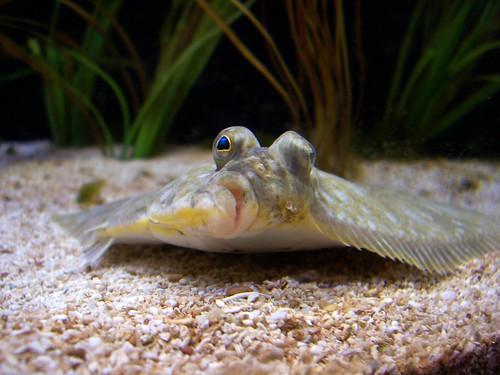I'm quite late with this, it's already been reported here, here and elsewhere, but it's too cool not to merit a little post.
I first learned about these fossils from the author of the paper, Matt Friedman of the University of Chicago, almost exactly a year ago at the International Symposium on Early Vertebrates that was held here in Uppsala. I've been on the lookout for the publication since then and I've really needed it more than once to give a current and striking example of intermediary forms. Now then, it's here.
Flatfishes are a funny sight. Laying flat on the ocean floor, perfectly camouflaged, eyes peering out over the sand and pebbles, looking for their unfortunate prey. The flat shape, an adaptation for this sort of predation, is shared with rays and skates (cartilaginous fishes, related to sharks more than to the flatfishes which are bony fishes). But unlike the rays and skates which lay flat on their bellies with their eyes on the top of their heads, flatfish lay flat on their sides. For any other fish, this position would mean that one of their eyes would be turned down to the bottom, with no apparent good use. But not for flatfish. During the transition from a free-swimming larval stage to the bottom-dwelling adult stage, one of the eye sockets grotesquely "wanders" from one side of the skull to the other, resulting in flatfish having both eyes on one side of their heads. This video shows what happens.

Ref: Flickr
The evolutionary explanation behind this freaky transition has been hotly debated ever since Darwin's time, not least by design proponents and evolution denialists who hold that flatfish must have "appeared" as they are. It's been argued even within conventional (read: real) science whether or not the flatfishes are results of an instantaneous saltatory evolutionary event, as opposed to slow gradual change. The subject has been a difficult one to enlighten, partly due to the lack of intermediary fossils, and partly due to the fact that flatfish belong to a group of fishes, acanthomorphs, that have very varied morphologies and rapid diversification.
The fossils examined in the article, Heteronectes and Amphistium, effectively end the discussion. They exhibit the tell-tale features that make it possible to establish confidently that they share a common ancestor with now living flatfish very early in flatfish evolution; and significantly, one of the eye sockets doesn't cross the dorsal midline of the skull. In other words, we have a fossil of an early flatfish where the eyes are on opposite sides of the skull, but one of them is "on its way" to the other side. The image below illustrates the transitory steps in the evolution of flatfish skull asymmetry with Heteronectes and Amphistium and two modern flatfishes.

Ref: The Loom
There's another very interesting thing about these fossils, and it seems to have been overlooked somewhat in the reports. It turns out that there are two morphs of Amphistium specimens: either right-sided or left-sided. Now living flatfishes typically only show one of the morphs, left or right depending on the species, with the exception of a primitive flatfish species called Psettodes in which both morphs occur almost at the same rate. This is interesting because it reflects a general pattern in evolution. In the evolution of asymmetries that arise later in development, there seems to be an early phase that is more "loose", where asymmetries are present in both directions, followed by a later phase where the groups have "decided" on one direction or the other.
Friedman, M. (2008). The evolutionary origin of flatfish asymmetry. Nature, 454(7201), 209-212. DOI: 10.1038/nature07108
Swedish blog tags: Vetenskap, Biologi, Evolution, Kreationism
Technorati tags: Science, Biology, Evolution, Fossil, Flatfish, Creationism
Hej D!
ReplyDeleteJag såg på TV att det hittat något mellanting av fiskan som levde i vattnet och fisken som gick upp på land (jag vet, väldigt ovetenskapligt skrivet av mig men jag ärinte så insatt;)), du kanske vet mer om detta också?
Det är nog Tiktaalik du har sett. Kanske den viktigaste och mest spektakulära fossila "mellanformen" som hittats.
ReplyDelete